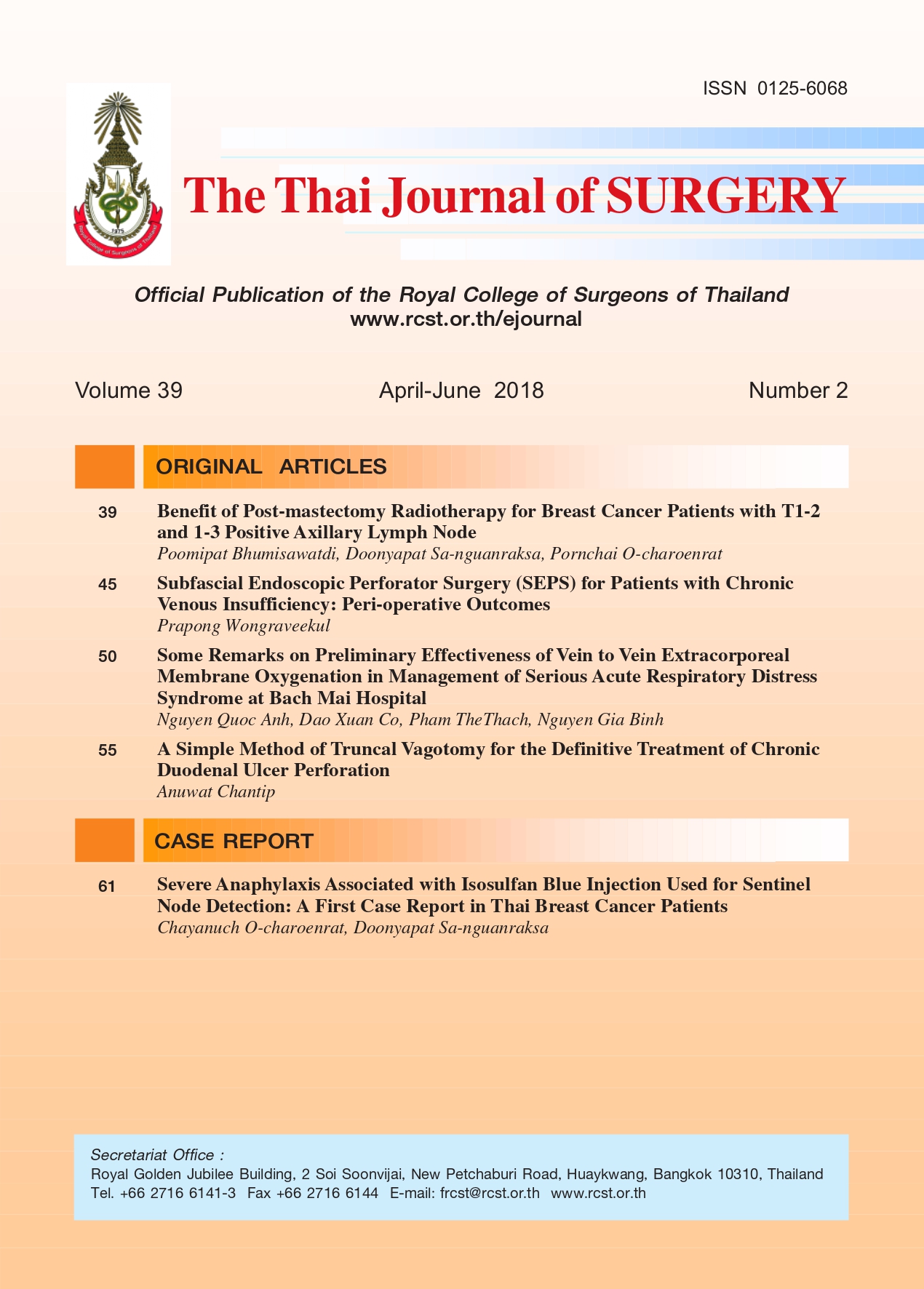A Simple Method of Truncal Vagotomy for the Definitive Treatment of Chronic Duodenal Ulcer Perforation
Keywords:
Truncal vagotomy, chronic duodenal ulcer perforation, recurrent duodenal ulcer perforationAbstract
Objective: To present a simple method of truncal vagotomy procedure, especially for the posterior vagal trunk, for standard definitive treatment of chronic duodenal ulcer perforation, in operable patients with suspected low compliance to receive a complete course of postoperative Helicobacter pylori eradication.
Material and methods: A retrospective review of patients who underwent truncal vagotomy and pyroloplasty versus simple closure of perforation site for chronic duodenal ulcer perforation between September 2012 and June 2017. Clinical characteristics and surgical outcomes of patients, and details of surgical techniques for easy posterior truncal vagotomy were described.
Result: There were 28 chronic duodenal ulcer perforation patients in this study. Sixteen patients underwent simple closure perforation site with non-absorbable suture. Twelve patients underwent truncal vagotomy and modified Heineke-Mikulicz pyloroplasty. The ASA functional classification, co-morbid diseases and baseline characteristic of patients between both groups were similar. The operative time was also not significantly different between operations. There was no morbidity and mortality at the 30 days of follow up.
Conclusion: Simple posterior truncal vagotomy can be done safely with similar operative time as for simple closure in patients with perforated chronic duodenal ulcer.
References
2. Lagoo J, Pappas TN, Perez A. A relic or still relevant: the narrowing role for vagotomy in the treatment of peptic ulcer disease. Am J Surg 2014;207:120.
3. Druart ML, Van Hee R, Etienne J, et al. Laparoscopic repair of perforated duodenal ulcer: a prospective multicenter clinical trial. Surg Endosc 1997;11:1017-20.
4. Zittel TT, Jehle EC, Becker HD. Surgical management of peptic ulcer disease today: indication, technique and outcome. Langen-becks Arch Surg 2000;385:84-96.
5. Bucher P, Oulhaci W, Morel P, et al. Results of conservative treatment for perforated gastroduodenal ulcers in patients not eligible for surgical repair. Swiss Med Wkly 2007;137:337-40.
6. Donovan AJ, Berne TV, Donovan JA. perforated duodenal ulcer: an alternative therapeutic plan. Arch Surg 1998; 133:1166-71.
7. Fischbach LA, Goodman KJ, Feldman M, Aragaki C. Sources of variation of Helicobacter pylori treatment success in adults worldwide: a meta-analysis. Int J Epidermal 2002; 31:128-39.
8. Sivri B. Trends in peptic ulcer pharmacotherapy. Fundam Clin Pharmacol 2004;18:23-31.
9. Malfertheiner P, Megraud F, O’Morain C, et al. Current concepts in the management of helicobacter pylori infection: the Maastricht III Consensus Report. Gut 2007; 56:772-81.
10. Schwesinger WH, Page CP, Sirinek KR, et al. Operation for peptic ulcer disease: paradigm lost. J Gastrointest Surg 2001;5:438-443.
11. FY L e, Leung KL, Lai BS, et al. Predicting mortality and morbidity of patients operated on for perforated peptic ulcer. Arch Surg 2001;136:90-4.
12. Arici C, Mesci A, Dincer D, et al. Analysis of risk factors predicting (affecting) mortality and morbidity of peptic ulcer perforation. Int Surg 2001;92:147-54.
13. Kocer B, Surmeli S, Solak C, et al. Factors affecting mortality and morbidity in patients with peptic ulcer perforation. J Gastroenterol Hepatol 2001;22:565-70.
14. Bucher P, Oulhaci W, Morel P, et al. Results of conservative treatment for perforated gastroduodenal ulcer in patients not eligible for surgical repair. Swiss Med Wkly 2007;137:337-40.
15. Moller MH, Shah KJ, et al. Risk factors in patients surgically treated for peptic ulcer perforation. Scand J Gastroenterol. 2009;44:145-52. 142. Following 152.
16. Boey J, Choi SK, Poon A, Alagaratham TT. Risk stratification in perforated duodenal ulcers. A prospective validation of predictive factors. Ann Surg 2001;205:22-6.
17. Uccheddu A, Floris GM, Altana M, et al. Survey for perforated peptic ulcer in the elderly. Evaluation of the factors influencing prognosis. Hepatogastroenterology 2003; 50:1956-8.
18. Tsugawa K, Koyanaki N, Hashizume M, et al. The therapeutic strategies in performing emergency surgery for gastroduodenal ulcer perforation in 130 patients over 70 years of age. Hepatogastroenterology 2001;48:156-62.
19. Linder MM, Wacha H, Feldmann U, et al. The Mannheim peritonitis Index. An instrument for the intraoperative prognosis of peritonitis. Chirurg 2001;58:84-92.
20. Bertleff MJ, Lange JF. Laparoscopic correction of perforated peptic ulcer: first choice? A review of literature. Surg Endosc 2010;24:1231-9.
21. Cellan-Jones CJ. A rapid method of treatlment inperforated duodenal ulcer. Br Med J 1929;1:1076-7.
22. Jani K, Saxena AK, Vaghasia R. Omental plugging for largesized duodenal peptic perforations: a prospective randomized study of 100 patients. South Med J 2006;99;467-71.
23. Lal P, Vindal A, Hadke NS. Controlled tube duodenostomy in the management of giant duodenal ulcer perforation: a new technique for surgically challenging condition. Am J Surg 2009;198:319-23.
24. Gupta S, Kaushik R, Sharma R, et al. The management of large perforations of duodenal ulcers. BMC Surg 2005;5:15.
Downloads
Published
How to Cite
Issue
Section
License
Articles must be contributed solely to The Thai Journal of Surgery and when published become the property of the Royal College of Surgeons of Thailand. The Royal College of Surgeons of Thailand reserves copyright on all published materials and such materials may not be reproduced in any form without the written permission.


